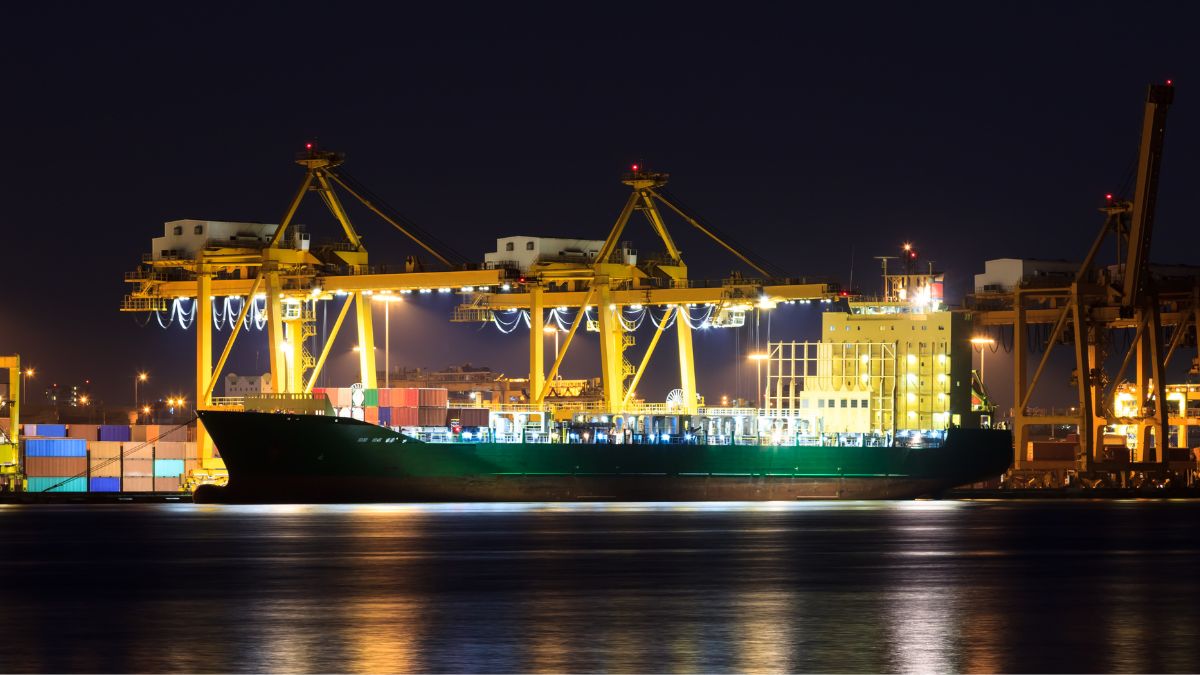BUSINESS
0 Kia Soul: The Future of Korea’s Export Container Shipping

Introduction to the Kia Soul 0
The Kia Soul 0 has emerged as a game-changer in Korea’s export container shipping landscape. This innovative vehicle is not just about stylish design and compact dimensions; it’s redefining how goods are transported across borders. With the rise of global trade, efficient solutions are essential, and the Soul 0 stands at the forefront of this evolution. As we delve into what makes this model so significant for Korea’s economy and its impact on international shipping, you’ll discover why it’s becoming an indispensable asset in logistics. Buckle up as we explore how the Kia Soul 0 is steering towards a new era in container shipping!
The Evolution of Container Shipping in Korea
Korea’s container shipping industry has undergone remarkable transformation over the years. From humble beginnings in the late 1960s, when traditional cargo ships dominated trade routes, it embraced modernization with a focus on efficiency.
The introduction of standardized containers revolutionized how goods were transported. This shift allowed for faster loading and unloading at ports, significantly reducing turnaround times.
As global trade expanded, Korean shipping companies adapted by investing in state-of-the-art vessels and technology. The rise of mega-container ships enabled them to compete on an international scale.
Additionally, strategic partnerships with other nations bolstered Korea’s position as a key player in maritime logistics. Ports like Busan have evolved into bustling hubs that cater to increasing demands from exporters worldwide.
This evolution reflects not just technological advancements but also Korea’s commitment to enhancing its global trade capabilities while ensuring sustainable practices are incorporated into operations.
Advantages of Using the Kia Soul 0 for Export Container Shipping
The Kia Soul 0 stands out as an innovative solution for export container shipping. Its compact design allows for efficient space management, maximizing cargo capacity.
Fuel efficiency is another key advantage. The 2.0 Kia Soul boasts impressive mileage, reducing overall transportation costs significantly.
Durability contributes to its appeal in global trade. Built with robust materials, it withstands the rigors of long journeys across diverse terrains.
Moreover, the vehicle’s adaptability shines through various configurations tailored specifically for container handling. This versatility makes loading and unloading a breeze.
Additionally, its eco-friendly features align perfectly with modern sustainability goals—appealing to businesses focused on reducing their carbon footprint.
Advanced technology enhances safety during transport while providing real-time tracking capabilities—a game changer for logistics management in today’s fast-paced market.
Challenges and Solutions for Implementing the Kia Soul 0 in Global Trade
Implementing the Kia Soul 0 in global trade presents several challenges that need addressing. One major issue is regulatory compliance across different countries. Each region has its own set of rules, which can complicate shipping processes.
Another challenge lies in logistics and distribution networks. Ensuring seamless integration with existing systems requires careful planning and coordination.
Additionally, there’s the matter of market acceptance. Educating potential users about the benefits of using the Kia Soul 0 for container shipping is essential to drive adoption.
Technological advancements also play a crucial role. Continuous innovation will be necessary to enhance efficiency and sustainability within export operations.
Partnerships with local businesses can ease entry into new markets, creating a supportive network for successful implementation. Establishing strong relationships will foster trust and pave the way for smoother transactions globally.
The Impact of the Kia Soul 0 on Korea’s Economy and Trade Relations
The Kia Soul 0 is more than just a vehicle; it’s a game changer for Korea’s economy. This innovative model has the potential to enhance export efficiency significantly.
By streamlining logistics, the Kia Soul 0 can reduce transportation costs. Lower expenses mean higher profits for businesses engaged in global trade.
Moreover, this model fosters stronger trade relations with international partners. As Korea improves its shipping capabilities, foreign markets take notice. They become more inclined to engage in business deals with Korean exporters.
Increased exports create job opportunities within the country as well. The demand for skilled workers rises alongside production efforts and supply chain management improvements.
Investments in technology related to the Kia Soul 0 may also lead to advancements across various sectors within Korea’s economy, setting a precedent for future innovations that align with sustainability goals and increased competitiveness on the global stage.
Future Possibilities and Developments for the Kia Soul 0 in Container Shipping
The Kia Soul 0 holds immense promise for the future of container shipping. As technological advancements continue, we can expect enhancements in fuel efficiency and eco-friendliness from this vehicle.
Innovative features like smart logistics integration could revolutionize how goods are transported. Imagine real-time tracking systems that optimize routes based on traffic and weather conditions.
Additionally, partnerships with tech companies may lead to autonomous driving capabilities for the Kia Soul 0. This would significantly reduce labor costs while increasing safety on the roads.
With a focus on sustainability, electric variants of the Kia Soul 0 could become standard in export operations, aligning with global green initiatives.
The potential for modular design allows flexibility in cargo space management, making it adaptable to various shipping needs. As Korea continues to evolve as a leader in trade, the Kia Soul 0 is poised for a transformative role in its economic landscape.
Conclusion
The Kia Soul 0 represents a significant leap forward in Korea’s export container shipping landscape. Its unique blend of efficiency and innovation positions it as a game-changer for exporters navigating the complexities of global trade. The evolution of container shipping in Korea has set the stage for this new model, showcasing how adaptability can lead to improved logistics solutions.
Using the Kia Soul 0 offers numerous advantages, from enhanced fuel efficiency to increased cargo space. However, challenges remain—particularly regarding infrastructure adjustments and regulatory compliance. Addressing these issues will be crucial as businesses integrate this vehicle into their supply chains.
The impact on Korea’s economy is notable as well; with stronger trade relations bolstered by efficient transportation options like the Kia Soul 0, economic growth appears promising. As manufacturers invest further in developing this model for broader use, we may see even more innovative solutions emerge within the realm of export container shipping.
Looking ahead, possibilities abound for expanding the capabilities of the Kia Soul 0 in international markets. With ongoing enhancements and adaptations to meet diverse needs across various sectors, its role could evolve dramatically over time—a testament to Korea’s commitment to leading advancements in global shipping practices.
BUSINESS
How Adsy.pw/hb5 Can Transform Your Digital Marketing Strategy

Introduction to Adsy.pw/hb5
In the fast-paced world of digital marketing, staying ahead of the curve can feel like an uphill battle. With so many tools and strategies at your disposal, finding one that truly delivers results is crucial. Enter Adsy.pw/hb5—a game-changing platform designed to elevate your marketing efforts. Whether you’re a small business owner or part of a large corporation, this innovative tool could be just what you need to transform your approach. Curious about how it works? Let’s dive into the features and benefits that make Adsy.pw/hb5 a must-try for anyone serious about boosting their digital presence.
The Benefits and Features of Adsy.pw/hb5
Adsy.pw/hb5 offers a plethora of benefits that can elevate your digital marketing game. Its user-friendly interface ensures even beginners can navigate easily, making it accessible for all skill levels.
One standout feature is its powerful analytics dashboard. This allows you to track campaign performance in real time. You’ll gain insights into what works and what doesn’t, enabling data-driven decisions.
Another advantage is the extensive range of customization options available. Tailor your campaigns to closely match your brand identity and audience preferences effortlessly.
Adsy.pw/hb5 also supports seamless integration with various platforms, enhancing workflow efficiency. Whether you’re using social media or email marketing tools, everything aligns smoothly.
The platform’s affordability sets it apart too, providing exceptional value without sacrificing quality. You get advanced features at a fraction of the cost compared to other services in the market.
Case Studies: Success Stories from Businesses Using Adsy.pw/hb5
Several businesses have harnessed the power of adsy.pw/hb5 to elevate their digital marketing efforts. One notable case is a local e-commerce store that saw a 150% increase in sales within just three months. By leveraging targeted ads and optimizing their content using adsy.pw/hb5, they reached new audiences effectively.
Another example involves a tech startup that struggled with brand visibility. After integrating adsy.pw/hb5 into their strategy, they reported significant growth in web traffic and engagement rates. Their innovative use of analytics helped refine campaigns for better performance.
A small restaurant chain also experienced remarkable success after adopting this tool. They utilized geo-targeting features to attract nearby customers, resulting in packed dining rooms during peak hours.
These diverse examples illustrate how versatile and impactful adsy.pw/hb5 can be across various industries. Each business found unique ways to maximize its potential, proving adaptability is key in digital marketing today.
How to Implement Adsy.pw/hb5 in Your Digital Marketing Strategy
Implementing Adsy.pw/hb5 in your digital marketing strategy is straightforward. Start by signing up and creating an account on the platform. This step unlocks access to its robust suite of tools designed for marketers.
Next, explore the various features available, such as keyword analysis and campaign tracking. Familiarizing yourself with these functions will enhance your understanding of how they can benefit your marketing efforts.
Once you are comfortable navigating the interface, integrate it into existing campaigns. Use it to optimize content and improve engagement rates across different channels.
Don’t forget to set clear goals for what you want to achieve with Adsy.pw/hb5. Monitoring performance metrics regularly will help in fine-tuning strategies based on real-time data insights that the platform provides.
Encourage collaboration among team members using shared dashboards within Adsy.pw/hb5 for transparent communication and streamlined processes.
Tips for Maximizing Results with Adsy.pw/hb5
To maximize results with adsy.pw/hb5, start by clearly defining your target audience. Understanding their needs and preferences can help tailor your campaigns effectively.
Use A/B testing to experiment with different content formats and messaging. This approach allows you to identify what resonates best with your audience.
Leverage analytics tools available within adsy.pw/hb5. Regularly monitor key performance indicators to adjust strategies in real-time for better outcomes.
Incorporate user-generated content into your marketing efforts. Engaging customers this way not only builds trust but also enhances brand loyalty.
Don’t underestimate the power of collaboration. Partnering with influencers or complementary businesses can amplify your reach significantly.
Keep learning about industry trends and updates related to digital marketing tools like adsy.pw/hb5. Staying informed enables you to adapt quickly and innovate continuously.
Comparison with Other Digital Marketing Tools
When evaluating digital marketing tools, it’s crucial to understand what sets adsy.pw/hb5 apart. Unlike many platforms that focus solely on social media management or email automation, adsy.pw/hb5 integrates various functionalities into one comprehensive solution.
Many tools require multiple subscriptions for different services, leading to higher costs and fragmented strategies. Adsy.pw/hb5 streamlines this process by offering a cohesive platform where users can manage everything from content creation to analytics in one place.
Additionally, while other tools may offer generic templates and features, adsy.pw/hb5 emphasizes customization tailored to specific business needs. This personalized approach enhances user experience and drives better results.
The user-friendly interface of adsy.pw/hb5 also stands out when compared with more complex alternatives. This simplicity allows marketers at all skill levels to navigate the platform effectively without extensive training or support.
Conclusion and Final Thoughts
Adsy.pw/hb5 presents an innovative approach to digital marketing, allowing businesses to harness the power of targeted advertising effectively. Its unique features and benefits cater to various business needs, making it a versatile tool for marketers.
The success stories from companies that have implemented adsy.pw/hb5 showcase its potential in transforming marketing strategies. By analyzing real-life case studies, it’s clear how this platform can lead to increased engagement and conversions.
Implementing adsy.pw/hb5 into your strategy is straightforward. With a few simple steps, you can start leveraging its advantages right away. Additionally, following practical tips will help maximize your results, ensuring you get the most out of this powerful tool.
When compared with other digital marketing tools on the market, adsy.pw/hb5 stands out for its user-friendly interface and effective targeting capabilities. This makes it an attractive option for both seasoned marketers and those new to digital advertising.
Embracing what adsy.pw/hb5 offers could be a game-changer for your business’s online presence. As you explore this dynamic platform further, consider how it aligns with your goals and aspirations in the ever-evolving landscape of digital marketing.
-

 TECHNOLOGY12 months ago
TECHNOLOGY12 months agoTop 5 Tips for Mastering in_a_dndmixin_drag in Your Campaigns
-

 TOPIC11 months ago
TOPIC11 months agoExploring the History and Culture of Rosewellsk
-

 TECHNOLOGY12 months ago
TECHNOLOGY12 months agoYMoviesHD vs Other Streaming Platforms: A Comprehensive Comparison
-

 TOPIC12 months ago
TOPIC12 months agoBehind the Scenes: The Philosophy and Vision of PhmHaven
-

 TOPIC12 months ago
TOPIC12 months agoThe Rise of Tribute Printed Pics: Honoring Life Through Photography
-

 TOPIC11 months ago
TOPIC11 months agoA Beginner’s Journey with Lwedninja: From Novice to Pro
-

 TOPIC11 months ago
TOPIC11 months agoIs Finizona Free? Unpacking the Costs Behind This Popular Platform
-

 TOPIC11 months ago
TOPIC11 months agoDecoding m0therearf: Why This Buzzword Matters in Today’s Culture
